
Highlights of Tibet Winter Tour
If you are planning a budget tour to Tibet, then you need to know how to save money on your tour, to make the best out of it. Winter tours are the best choice for people wanting to tour Tibet on a budget, and it can make the tour even more affordable than you thought. So what are the benefits of touring Tibet in winter?
Why Tourists and Budget Travelers Should Visit Tibet in Winter
One of the biggest myths of touring in Tibet is that it is too cold in winter, and you will get too cold. With the higher altitude, the air is thinner, making it warmer once the sun comes out than at lower altitudes. So, even in the depths of winter, a nice sunny day can be warm enough to make you lose that thick Jacket. Snow is also a rarity in most parts of Tibet, and it actually snows less than in many cities in Northern China.
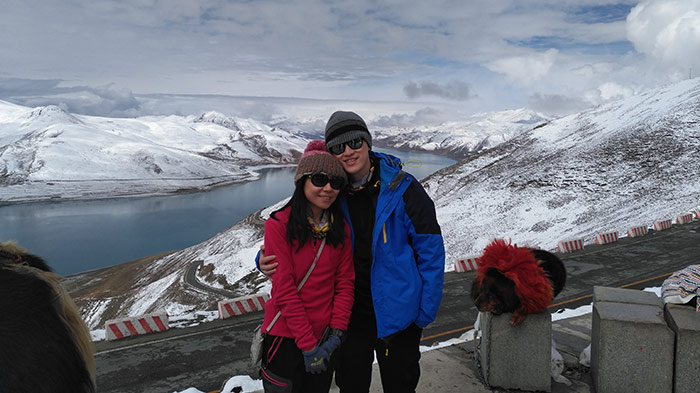 Tourists are appreciating the snow-covered landscape of Yamdrok Lake in Winter
Tourists are appreciating the snow-covered landscape of Yamdrok Lake in Winter
Winter normally runs from November to mid-February, and since it is winter, the temperatures at night can plummet to well below freezing, giving a big range difference between night and day. Temperatures range from minus ten degrees to around 10-12 degrees in winter, and while it may not be to the liking of some, it is the perfect time to view this beautiful plateau landscape.
For budget travelers, it is the ideal time to tour Tibet in winter. With it being the off-season for tourists, there are many discounts that can be availed of, which is of benefit to budget travelers. Hotels, flights, attractions, festivals, and even train tickets are often cheaper in the off season for Tibetan tourism, so you can make really big savings on your trip.
Top Highlights of Tibet Winter Tour
Lhasa to EBC Tour
Because everyone makes the wrong assumption that it is unbearably cold on the Tibetan Plateau in winter, tourists congregate in the warmer months, especially from late spring to early fall. The droves of Chinese tourists begin to clear out after the early October Chinese national holidays, and by December and January there are hardly any tourists at all. Pilgrims from all over Tibet pour into Lhasa during the winter months, visiting the Jokhang and the major monasteries. You can see Tibetans from all walks of life, and experience Lhasa’s devout heart - multitudes of Tibetans practicing Tibetan Buddhism.
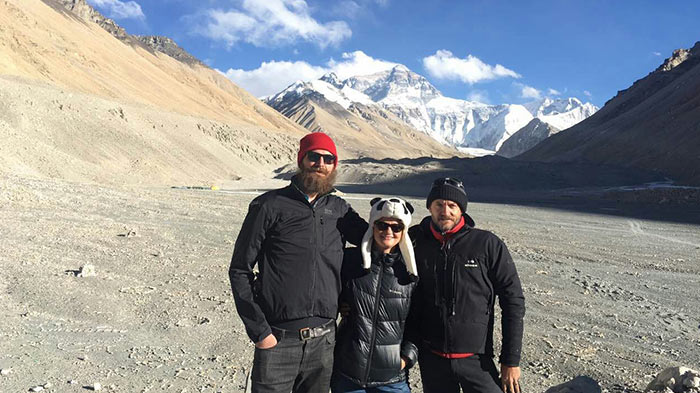 EBC Tour in Winter
EBC Tour in Winter
With fewer tourists on the roads, it is easier to get into places such as the many temples and monasteries between Lhasa and the Nepal border, and the view at Everest Base Camp is strikingly spectacular, with clearer definition and the best time to take photographs. There are also fewer people visiting EBC in winter, which makes it a more serene and relaxing place to be.
The road from Lhasa to EBC is normally fairly busy in the summer months, and places to stay are sometimes full. However, in winter, there are just as many things to see and do along the road, in Gyantse, Shigatse, and at EBC itself, and the sights are a wonder to behold. the heights of the Himalayan mountains are covered in snow, and the many peaks look like jagged white teeth stretching up to bite the sky.
Grand Tibetan Festivals in Winter
Palden Lhamo Festival
The Palden Lhamo festival happens on the 15th day of the 10th lunar month in the Tibetan calendar, to honor a wrathful deity called Palden Lhamo, the only female among the “Eight guardians of the Law”. She acts as Tibet's protector deity, a defender of Buddhism in Tibet, and the special protector of the Panchen Lama and the Dalai Lama who are the religion's traditional main leaders. Palden Lhamo is revered as a female deity who has three eyes and rides a white horse with an eye on the rear of it, and on the festival day in Barkhor Street in Lhasa, people parade a float of her and carry figures of the goddess.
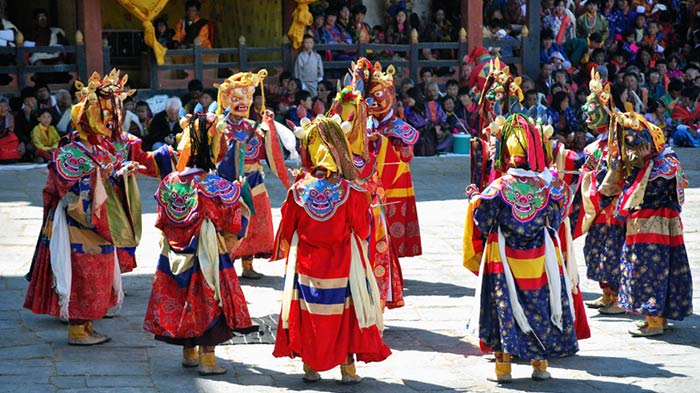 Palden Lhamo Festival
Palden Lhamo Festival
According to Tibetan legend, the daughter of Palden Lhamo, White Lhamo, fell in love with the guardian of the Jokhang temple, and decided to marry him without consent. Annoyed by her daughter’s behavior, Palden Lhamo drove the guardian from the temple to the south side of the Lhasa River, where White Lhamo could only gaze at him from the northern bank.
To show their pity for poor White Lhamo, Tibetan women worship her during the festival, and pray for their own love to come. On the day of the festival, the women get up early and go to Barkhor Street to burn juniper branches and other plants in honor of the goddess, before going to pray in the famous Jokhang Temple.
Tsongkhapa Butter Lamp Festival
Every year on the 25th day of the tenth month in the Tibetan calendar, people celebrate the Tsongkhapa Butter Lamp Festival. The festival commemorates the death of Tsongkhapa, the great religious reformer who founded the Gelugpa school of Tibetan Buddhism in 1409. Although it is the latest sect, the Gelugpa sect now has the biggest influence in Tibet. When Tsongkhapa saw the corruption and disorder in Tibetan Buddhism at that time, he decided it was time for change and reform. He founded the Gelugpa sect to save Buddhism in Tibet, and make a new start for the people. In Tibetan, gelug means “Good Discipline”, and the sect was built and focuses on strict disciplines and restricted monastic lives. With the good management of the order, Gelugpa soon spread across Tibet, winning the hearts of the people.
Today, Tibetans all over Central and Eastern Tibet lit butter lamps in monasteries, temples and their homes to remember this great lama. Lama Tsongkhapa’s seat was in Ganden monastery near Lhasa, and his tomb is located there now. So on this particular day, there is a special ceremony held there for the whole day, to commemorate this great master. In Barkhor Street, in Lhasa, myriads of butter lamps are lit on rooftops and windowsills with prayers chanted to commemorate the parinirvana of Tsongkhapa throughout the night.
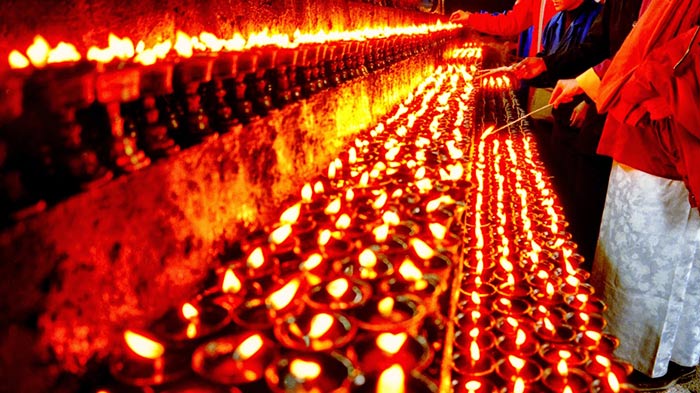 Tsongkhapa Butter Lamp Festival
Tsongkhapa Butter Lamp Festival
The Parinirvana or death celebrations are a very festive time, and are fueled with activities including Buddha Dance, puppet show and butter sculpture exhibitions staged by various monasteries. In daytime, people will steam into monasteries to pray. When night falls, they will stroll along places like Barkhor Street to maze at yak butter sculptures, the man-made wonders. Flanked with huge flower stands containing numerous butter sculptures, Barkhor Street will draw tens of thousands of people from far-flung towns and villages annually during this festival. When the lamps are lit up, the beauty of these art works will culminate. Barkhor Street will be the most dynamic place in Tibet on this day, and it is a time to rub shoulders with the locals, to delve into the authentic local life, to be carried away by the splendid butter sculptures, and to take a unique peek into their spiritual realm.
The evening and night is one of prayer and the spinning of prayer wheels, as well as lighting juniper and cypress branches in front of Jokhang temple, their voices lifting into the night sky on the drifting smoke. There is also a special food that is eaten on the day, called tsampa porridge. Made from the traditional highland barley flour with tea and a little salt, it is made a little more runny than the traditional tsampa that is eaten at every meal across the region.
Tibetan New Year
The Tibetan New Year - Losar - is the most popular festival of the Tibetan calendar, and while it is meant to be just a three-day festival, it can last for up to two weeks of celebrations. The main celebrations happen during the first three to seven days, depending on the region. The period before Losar is the time when people prepare for the celebrations, and decorate their houses and the streets, as well as preparing food for the celebration.
Tibetans stay at home on the first day of the New Year, to spend it with their family, the most important people in their lives. On the morning of the New Year, the people rise before daybreak to burn pine rosin and place dyed barley and ears of wheat on the roof of the house, as a wish for a prosperous New year. The women also get up early to collect water from the nearest river or lake. The first water of the new year is considered auspicious, and the family wait at home for the women to return, so they can wash their faces with the auspicious water.
 People have prepared food for the celebration of New Year
People have prepared food for the celebration of New Year
Once they are washed, and any livestock are fed, the family will dress in their finest clothes. Men put on fine robes and leather boots, while the women dress in colorful aprons known as “Bangdian” and headdresses decorated with corals, pearls, agate, and other precious gems. The mother of the family will then proffer the family’s Qiema box to each member of the family, and each will take a little tsampa from the box. As they take the food, they give thanks to the mother and the rest of the family with prayers and traditional greetings such as “Tashi Delek” (all the best, or Blessings and good luck).
On the second day of the New Year, Tibetans spend their time visiting friends and other relatives, to greet them with blessings for a good and auspicious new year. The host greets all visitors with the Qiema box, and the hostess pours tea and chang for their guests. Then, from the third day onwards, the celebrations and festivities start in earnest, with such ceremonies as the Weisang burning, where people burn cypress and pine branches and chant sutras to pray for peace, health, and a good harvest.
Preparations for the festivities can take almost as long as the celebrations themselves, and the families will prepare all the food they will eat during Losar, including the famous Guthuk, a traditional noodle soup that is normally eaten on the eve of the New year. During the festivities of the New Year, it is a popular practice to watch shows, such as plays and Tibetan opera, and for the people to sing and dance. The whole proceeding is a merry affair of celebration that continues until the fifteenth night of the first new moon. Just like at any other festival throughout the year, Tibetans love to have a good time, and spend long hours chatting with friends and relatives over bowls of tea and mugs of chang and barley beer.
Flocks of Pilgrims in Lhasa
Winter is the time for local Tibetans to do pilgrimage. In winter, the Tibetans have finished husbandry and swarm into Lhasa for worshipping. Numerous devout worshippers holding butter lamp come to the Potala Palace and the Jokhang Temple. If you want to learn more about the Tibetan Buddhism and explore the mystery of religion, going to Tibet in winter is your best choice.
Observe the Migratory Birds in Lhasa and Surroundings
Winter Birdwatching in Tibet is mainly centered around Lhasa, and the area becomes a birdwatcher’s paradise. Many of these species of birds are only found in Tibet in the winter, where they come for the warmer weather of the southern and southeastern valleys. The Lhasa river watershed is an important wintering area for a number of migratory and resident bird species, and the valleys are an important wintering area for around 1,300 Black-necked Cranes and 4,000 Bar-headed Geese.
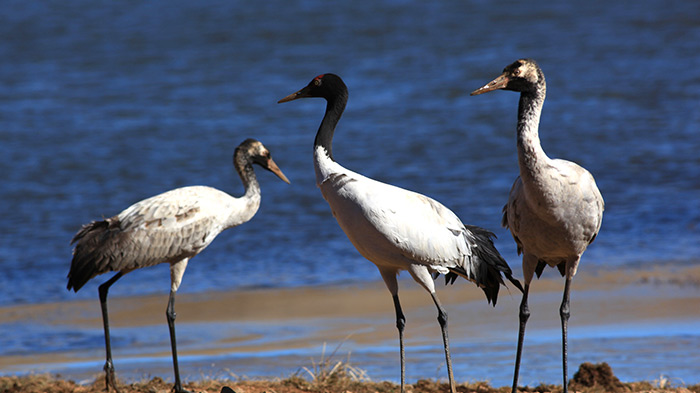 Black Neck Crane is one of the most famous birds
Black Neck Crane is one of the most famous birds
On the edge of the city lies the largest natural urban wetlands in the world, Lalu Wetland National Nature preserve. This huge expanse of natural wetland is surrounded on almost all sides by residential properties, and is known locally as the “Lung of Lhasa”. A haven for hundreds of species of wetland birds, who migrate in for the winter, the wetland is an excellent habitat for the local and migratory wildfowl, and attracts many of the species of migrating birds that you cannot always see elsewhere.
Every year thousands upon thousands of black-necked cranes head towards Lhünzhub County in Lhasa for their winter-feeding grounds. Only a short, 65km ride to the northwest of metropolitan Lhasa, it is a great place to study and photograph the black-necked cranes in their natural habitat. From December through to spring, the cranes spend their winter in the area of Lhünzhub County, with huge flocks nesting around the Hutoushan Reservoir, a major feeding ground for the cranes.

With exceptional passion and outstanding leadership, Mrs. Catherine has dedicated herself to Tibet inbound tourism and China tour for 15 years. As one of the handful females who see great potential of Chinese inbound tourism, Catherine has made great contribution to promoting Tibet tourism and enhancing the employment of Tibetans and prosperity of local Tibetan community.
Over the years, she travelled overseas with Tibet Tourism Bureau many times to promote Tibet tourism. Currently, Catherine works as the marketing director of Tibet Vista, an opinion leader behind the whole team of Tibet Vista.


.jpg)




0 Comment ON "Highlights of Tibet Winter Tour"